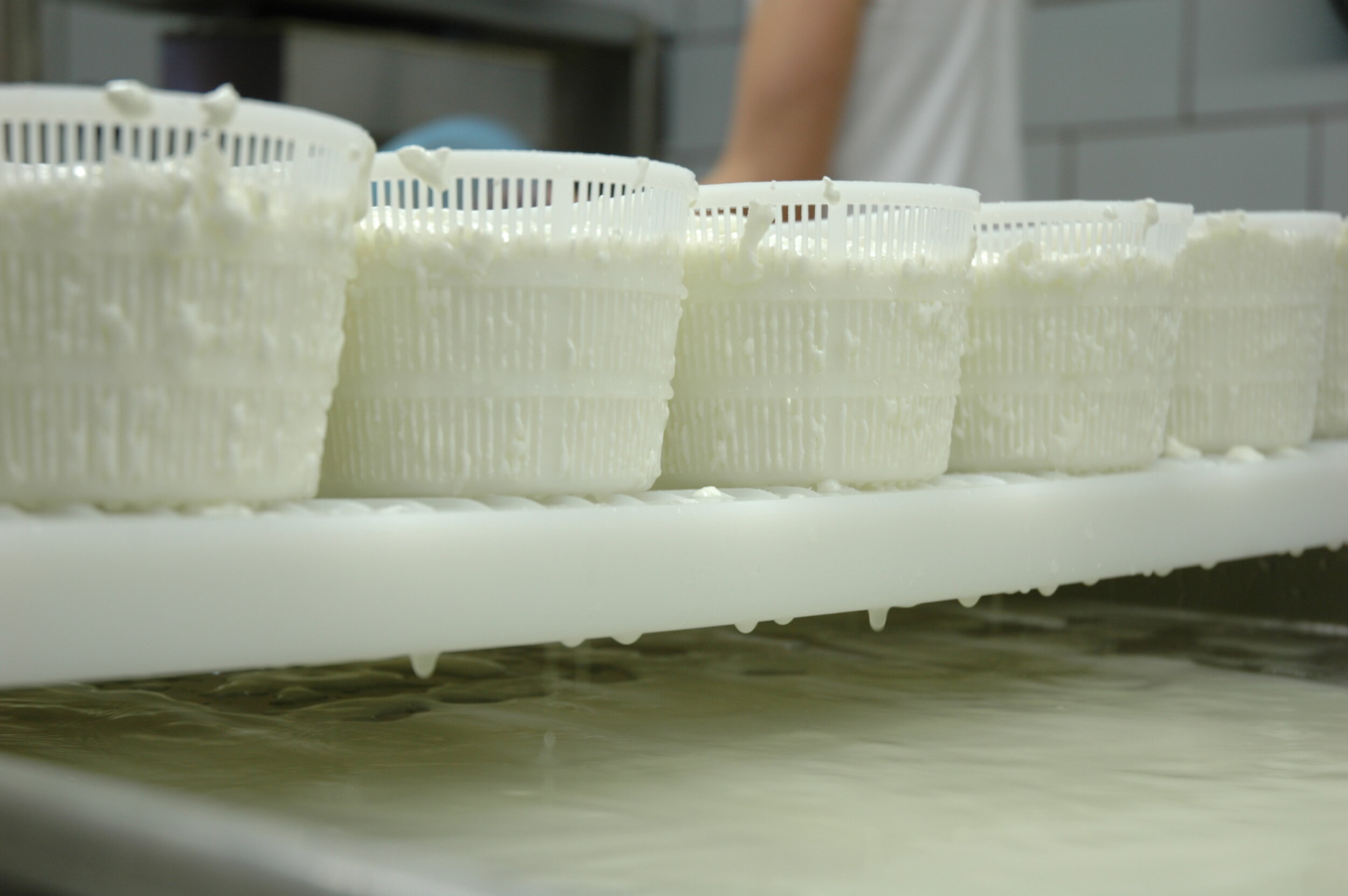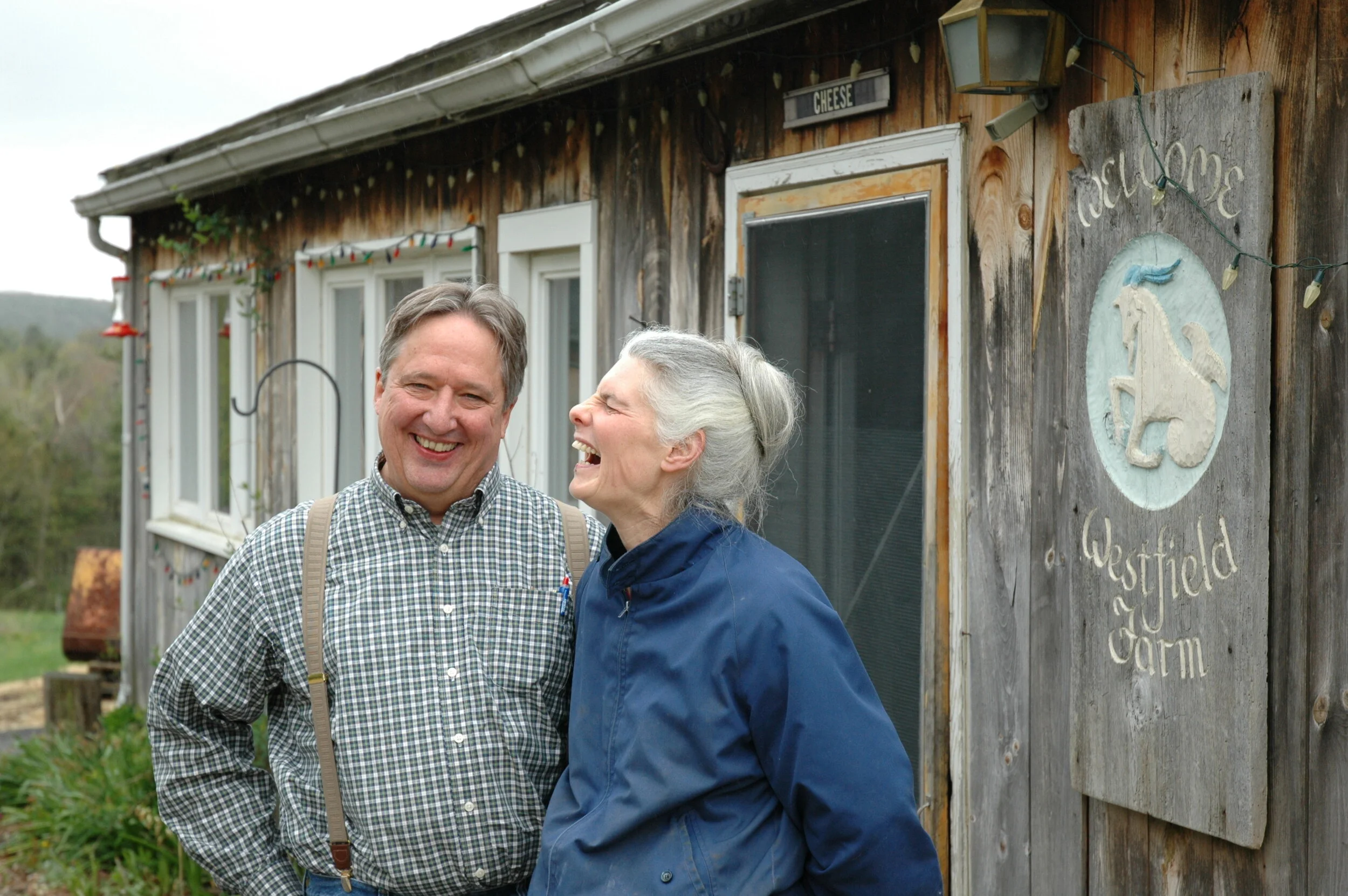Firefly Farms- Maryland
May 2006
Name: FireFly Organic Farm
Owners: Mike Koch, Pablo Solanet, Ron & Beth Brenneman
Location: Bittinger, Maryland
Animals: Recently sold off most of their 200 plus mixed herd. Currently purchasing milk from four, local Amish goat dairies
Cheeses/Products: Merry Goat Round, Allegheny Chevre, Mountain Top Bleu, Buche Noir...plus two aged goat milk cheeses that are only sold at farmers’ markets
We arrived at FireFly Farms one week after they had made a big change in their operation: no more goats on the farm. After much debate, the six people who collectively run the farm decided that the cost of labor involved in caring for 200 plus goats, the complexity of expanding the herd for more milk, and the ease of acquiring high-quality goat milk from other sources in their area meant that it was time to sell the herd. Andy, the office manager (this is the closest we could get to a job title that was loose enough to include all that she does), was concerned that we would be disappointed with this change on the farm while we were thinking- how much more interesting does it get to walk onto the scene after such a huge change?
FireFly made the Cheese by Hand cut because of its unique ownership setup. Four friends Mike Koch, Pablo Solanet, Ron & Beth Brenneman came together to combine their respective expertise- cheesemaking and dairying. One of the things we have noticed in small-scale cheesemaking is the burnout potential, especially with farmstead operations. We were intrigued to see if having four people on board meant a more sustainable lifestyle and to understand how well a farmstead cheese operation could support two families.
So we hauled our lot out to the western most point of Maryland. Although the landscape is incredible and we drove through the tip of the Appalachian Mountains on our way there, the overcast and stormy weather made the situation seem bleak. The road out to the farm is beautiful with rolling hills and loads of grazing cattle. We arrived just in time to clean up after the final batch of cheese was made. There are three full-time employees at FireFly: Matt, the current head cheesemaker (and Andy’s husband), and his apprentice, a 17 year old local named Dan. Matt gave us a tour and explained a bit more about the selling of the herd and what that has meant for the farm. At this point FireFly is receiving goats milk from four Amish goat dairies one to two times each week, storing it in a bulk tank, and pulling from that throughout the week making cheese two and three times each day. Like many other American artisan cheesemakers, FireFly cannot keep up with the demand for their cheeses.
Now that FireFly is receiving milk from other farms they can determine the quantity of milk that they have the capacity to turn into cheese. This is both a luxury and a burden (projecting sales is not always easy) although everyone involved seems comfortable with the arrangement they have made with their suppliers.
When they first started using milk from the local Amish dairies they had to take all milk being produced as they had no way of taking what they needed and then getting the rest to another producer. They were overwhelmed with milk for a couple months and forced to develop some new cheeses- they made two styles of aged goat’s milk cheeses- both are tommes, one is a washed rind- which turned out to be fantastic. Not only did they get two great new products from this too-much-milk predicament but they also retooled their relationship with the farms and connected with a milk distributer who now collects milk from the Amish dairies, drops off only what is needed at FireFly, and then takes the remaining milk onto other goat milk cheese producers. A winning situation for all parties involved.
Matt sent us on our way with bellies full of aged goats milk cheeses- mmmm- which we topped off with some excellent, surprisingly authentic Mexican food at El Camelo in the lovely little town of Frostburg (Frostburg State University anyone?).
The following morning we arrived in time to watch Dan put the Allegheny Chevre into cloth sacks, work some of the whey out of them and hang them to drain. Dan keeps the cheesemaking flowing a couple mornings each week while Matt drives their orders to Pittsburgh. The chevre had been cultured and set (rennet added) the night before and then left in the warm make room overnight. Another batch of milk had already been pumped into the pasteurizer so that by the time the chevre was hanging the milk in the pasteurizer would be ready to culture and set so that the next batch of cheese, soft-ripened Merry Goat Rounds, could be hooped later that afternoon. After clean up from chevre bagging and hanging, we watched Dan prepare for logging. Logging? Yes, logging.
Matt and Dan had alluded to the antiquated method they use to create their completely handmade chevre logs and buche noir. Having seen other cheesemakers make chevre logs during our trip we assumed they had a hand-crank extruder. It is even more "handmade" than that. Dan covered the work table with long strips of plastic wrap and began to lump chevre onto it, gradually forming it into a tube shape. Once he had a strip that ran almost the length of the table he wrapped the plastic around the fresh cheese, twisted the ends to seal them and began to stretch the tube by running his hand along it. "I had to lift for four weeks to develop the muscle set to do this," he explained while we picked our chins up off the floor. So we filled the next two stations on the assembly line to help out; Michael unwrapped the snake-like logs and cut them according to the cheese ruler while I wrapped each one in plastic and stacked them neatly on a tray so they could be moved into cold storage before being wrapped in cheese paper and shipped out.
The by-hand bit doesn’t end here. Once all the chevre was logged, cut, and plastic wrapped, we pulled the trays out and with each log we had to wrap them in cheese paper, attach an Allegheny Chevre label, stamp them with both the julian code and the batch number, and lastly, attach the hand-written weight sticker. Uhm. Wow. And to think that on a normal Tuesday, with Matt making deliveries, Dan would have done this work on his own. Impressive. By the time we had finished this up Matt was back from Pittsburgh and the two cheesemakers got busy with cutting, draining, and hooping curds for Merry Goat Rounds. As with all cheesemaking we’ve seen this is the part that goes by in the blink of an eye; before you know it you are back to cleaning.
Michael and I prepared to interview Matt and Andy who are managing the day to day operations at the creamery. We left Dan to prep another vat of chevre that would sit through the evening and be ready for bagging and draining the following morning. Michael asked him if he thought he would stick with cheesemaking for a while...I’ll paraphrase his answer- I started working when I was 12 (he was home schooled so his scheduled allowed him to do this) I’ve worked construction, I’ve worked as a butcher in a slaughterhouse and eventually I asked myself what kind of work I’d still be wanting to do when I’m 40. This is hard work but the temperature swing is only 50 degrees and that is better than standing outside on a roof in freezing rain and sleet. Plus I got in on the ground floor here- I’m going to stick around this place.
FireFly is lucky to have him- we’d be happy to log alongside him any day.







